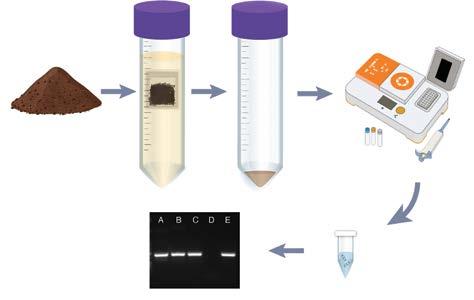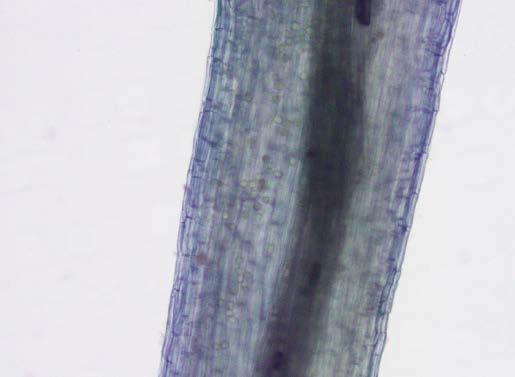
6 minute read
SMARTER DETECTION OF ROOT ROT PATHOGENS
Advances in molecular diagnostics are transforming how we detect soilborne pathogens like Phytophthora. Faster, more sensitive testing could mean earlier intervention and better disease management for New Zealand’s growers.
By Associate Professor Monica Gerth : Victoria University of Wellington
Soilborne pathogens are a persistent challenge for horticulture in New Zealand and worldwide. Among these, Phytophthora species are particularly problematic due to their ability to infect a wide range of plants, causing root rot and dieback diseases.
These pathogens are remarkably resilient, surviving in plants and soil as oospores – thick-walled, dormant spores that can survive until conditions favour infection. Globally, these microscopic foes are responsible for billions of dollars in crop losses, and New Zealand growers are no exception.

But what if we could detect (and treat) these pathogens quickly and accurately, before they cause significant damage?
About the team and project
My research group in the School of Biological Sciences at Victoria University of Wellington is interested in understanding how plants and microbes interact, and how this knowledge can be applied to develop practical and effective tools for managing plant diseases.
This particular project grew out of our ongoing efforts to develop effective treatments for Phytophthora diseases. We realised that without a reliable and quantitative diagnostic, it was difficult to evaluate whether a treatment was truly effective, or if a lack of disease symptoms was simply due to the pathogen being present at low levels (or not at all) on a particular plant. This need for robust diagnostics inspired our work on rapid, sensitive, and quantitative DNA-based detection methods for Phytophthora.
While our initial focus was on protecting iconic kauri forests, we believe this technology holds promise for horticulture across New Zealand. Understanding how these pathogens persist, spread, and respond to management is critical for effective disease control.
Why Phytophthora diseases are so challenging
Phytophthora species are among the most destructive plant pathogens globally. In New Zealand they threaten both native ecosystems and crops. For example, while P. agathidicida devastates kauri, P. cinnamomi threatens avocados, P. capsici attacks vegetables, P. infestans infects potatoes, and P. fragariae targets strawberries. Their ability to persist in soil as oospores, lying dormant for years, makes them especially difficult to control.
Traditional detection methods, such as soil baiting, are slow and often miss these hidden spores. Baiting involves placing susceptible plant material in soil samples and waiting weeks to see if disease develops – a time-consuming, expensive and often unreliable process, especially when oospores are dormant.
Faster, smarter pathogen detection with PCR
To overcome the limitations of traditional detection methods, we turned to PCR (polymerase chain reactions). This molecular technique amplifies tiny amounts of DNA, enabling the detection of even a single pathogen in a complex soil sample. PCR acts like a molecular photocopier, rapidly generating millions of copies of a DNA sequence unique to the target pathogen.

Our PCR-based method (see process diagram above) isolates and amplifies Phytophthora DNA from soil or plant material, delivering results within a single day, far faster than the weeks or months required by conventional techniques. We also made key advances in concentrating small, round dots inside the root are Phytophthora oospores – special survival spores made by the pathogen spores from soil (using ‘teabags’), extracting DNA from these tough spores, and identifying the pathogen based on its unique genetic signature.
In field trials in kauri forests, our test detected the pathogen in 69 percent of soil samples, compared to just 11 percent using standard baiting methods. Notably, our approach also costs about one-third of existing methods. This significant improvement in sensitivity, speed, and affordability enables earlier and more reliable detection, which could provide growers and land managers with a valuable advantage.
Beyond yes or no: quantitative detection for smarter decisions
Our diagnostics can do more than just confirm the presence of a pathogen, though; we can also measure the amount of pathogen in a sample, providing quantitative data. This lets us track how pathogen levels change across blocks or seasons, revealing disease hotspots and guiding targeted interventions.
This quantitative data is also invaluable for evaluating the effectiveness of treatments. After applying a treatment (such as phosphite for P. cinnamomi), follow-up testing can show whether pathogen levels are dropping as expected or if additional action is needed. This feedback loop helps refine management strategies, preventing unnecessary chemical applications and saving both time and resources.
Looking ahead, quantitative diagnostics could help establish economic thresholds for action, similar to those used in pest management. Rather than relying solely on visible symptoms or routine schedules, growers could use solid data to determine exactly when to intervene, supporting more sustainable and evidence-based decision-making.
Broader applications and practical considerations
Although our method was initially developed for P. agathidicida, the underlying technology is highly adaptable. Our next step is to apply it to other significant Phytophthora species affecting horticulture, such as P. cinnamomi in avocados and P. fragariae in berries. The same principles can be applied to citrus, ornamentals, and other crops vulnerable to Phytophthora pathogens.
A key advantage of this approach is its practicality. The PCR-based assay can be performed with compact, affordable and portable equipment (about the size of a briefcase), making on-site testing a realistic option. Our integrated protocol allows multiple samples to be processed in parallel, with results available on the same day. This combination of speed, sensitivity, and scalability marks a significant improvement over traditional methods.
Looking forward: partnering for progress
While no single tool can address every plant disease challenge, integrating quantitative molecular diagnostics into disease management offers a promising path forward. These methods empower growers to monitor pathogen levels, assess treatment effectiveness, and target interventions with greater precision.
By developing rapid, sensitive, and quantitative diagnostics, our goal is to help New Zealand’s growers stay ahead of soilborne threats, fostering healthier crops and more resilient orchards for the future.
We are eager to collaborate with growers and industry partners to adapt and refine these tools for a wider range of crops and pathogens. If you are interested in collaborating, please get in touch with us at monica.gerth@vuw.ac.nz
Funding: This research has been made possible through the much-appreciated support of Tiakina Kauri (part of the Ministry for Primary Industries), and research grants from the Ministry of Business, Innovation and Employment.










